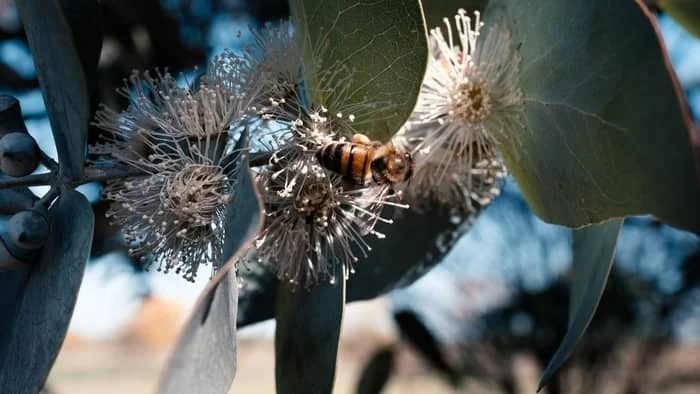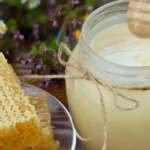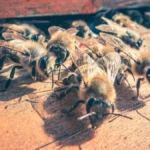If we look at a flower patch, bees can sometimes seem to be a bit mysterious as to when they appear and disappear. In this article, we have a look at the factors which affect what time of day bees come out. We have a look at when bees go away and explore whether they come out at night.
There are actually no hard and fast rules on these things, but there are some generalizations we can make. So let us divide this article into two. General normal conditions and how we can expect bees to behave and Exceptional abnormal conditions and how bees behave.
General Honey Bee Normal Conditions
Under normal conditions, which we can consider being average environmental conditions, honeybees are affected by the following.
Bee Activity From Changing Air Temperature
This is a very simple factor affecting bees. Bees need to be warm enough to fly. If the air is very cold the bees will gradually become cooler as they fly. When bees get cold they cannot produce enough energy in their wing muscles to fly. They will fall to the ground, or land on something and wait for it to get warmer so they can fly. If the temperature does not go up, the bee will eventually die.
Generally, below 50°F bees will make short trips out of the hive and if there are flowers close by they will visit them and shoot back to the hive. Most flights at this temperature are so-called “cleansing flights” – this is a polite way of saying toilet visits. Bees, like all animals, need to poop. They don’t do this in the hive.
Undertaker bees will also take dead bees out of the hive and drop them a bit away from the hive then shoot back inside before they get cold. When it is cold, you will see that bees are very quick to get back into the hive where it is warm.
As temperatures go up, bees become more active and you will see more and more flights. If it is warm, bees can fly further and scout out distant nectar resources. This will then translate into more and more activity as the profit margins per trip increase.
As temperatures drop later in the day, you may find activity will gradually decline as the “profit margin” per trip decreases. In other words, if the bees have to warm the workers up enough to get them to the nectar resource and back, there comes a point where the energy expended on warming the bee exceeds what the reward is. At this point, the bees will stop working that resource.
Light Intensity Affecting Bee Movement
Bees generally wake up and begin leaving the hive, assuming the temperature is high enough, just before sunrise. On a warm spring or summer’s day, we can therefore expect that the bees will be active from dawn to dusk.
You can watch this for yourself at a hive – when the ambient temperature is 70°F or so, and above, you will find the bees leaving the hive at dawn and working until dusk. This may vary a little from the race of bee to race of bee but it is a general rule.
Honey Bee Activity in the Moonlight
There are some records in different parts of the world, that, under full moon conditions, if the ambient temperature is mild and warm, that bees will work medium intensity honey flows. I have personally seen this in mid-summer in a number of parts of the world on a clear full moon night. Bees seem to be able to navigate by moonlight.
So now we have covered the normal conditions – in summary, bees don’t like to fly when it is too cold, and when it is warm, they are up at dawn and home by dusk.
Read more about: Do Queen Bees Leave The Hive?
Exceptional Abnormal Conditions
Bees are a bit like humans – there are rules, and there are times when rules get broken. Now we will have a quick look at the times when bees “break the rules” and do things that at first seem a bit unexpected.
Exceptional Flowers Impact on Bees
There are some honey flows that are just so amazing that bees are willing to do all sorts of weird and wonderful things to exploit these resources.
Eucalyptus Trees
Eucalyptus trees are very odd trees from Australia. These trees are adapted to exist with the native bees of Australia which generally lack the ability to navigate as far and accurately as honeybees. There are a number of other aspects of the biology of these bees that mean that they cannot operate at the same levels of efficiency as honeybees.
Flowers pay insect pollinators for pollination services with nectar. The amount of nectar a flower has to pay to be pollinated will be determined by the efficiency of the pollinator being paid. In the case of native Australian bees, these bees are fascinating and amazing in many ways, but, they are less efficient overall than honeybees. Consequently, Australian trees such as Eucalyptus are very generous in their “nectar payments”. When honeybees work on these trees they go completely crazy with the intense honey flow.
I have seen bees work 24 hours a day, in the middle of winter, with very low nighttime temperatures on Eucalyptus saligna and Eucalyptus grandis. Both tree species flower in the middle of winter. I have seen with my own eyes how bees fly straight out of the hive and onto the trees and back when ambient temperatures are as low as 50°F at night.
When the bees are working plantations of these trees you can see steam emerging from the mouth of the hive due to the huge volumes of nectar being dried and the low temperature. The amount of heat generated by the bees is incredible, and the bees are able to work 24 hours a day. It is very important to ensure proper ventilation with strong flows such as these in cold weather. If there is insufficient ventilation, condensation inside the hive causes chalkbrood problems.

Sugar Sources
I once had a person who would phone me every few months to have bees removed. She lived in an area that was a mixture of residential and industrial land close by. It was an old house and time had overcome her neighborhood. What was once a grand area was now a few tired old houses and ugly factories.
Just across the park from her, a large factory manufactured hard sweets and toffees. One of their main ingredients was glucose. There was a pump that pushed the glucose syrup up and along a long pipeline to the factory.
Free Glucose
Stainless steel is a funny metal and develops metal fatigue easily. The pulsing of the pump had caused a small crack to open on one of the welds and unbeknown to the factory, this crack squirted a little jet of glucose onto a nearby roof. Here the bees gathered and collected concentrated pure glucose and carted this back to their hives.
The result was that this lady had an endless stream of bee colonies that moved into her house and had access to unlimited free glucose. They just had to fly a few feet from the hive, drink glucose and stumble home. The hives were very busy, and in warm weather, active day or night.
Honey Bee Activity Through Environmental Changes
Generally, bees are inactive outside the hive when it is cold or dark. Bees come out when it is warm and light enough for them to do their work. If it is cold, they pop out to go to the lot. If they can get hold of very good nectar or sugar they will break all the above rules.
We hope this article was interesting – and also gave you a little chuckle. I will always think of those crazy beehives when I see glucose sweets. Share if you enjoyed it.
Learn more about: What Time Of Day Do Bees Swarm?
Honey Bee Activity FAQs
When do bees typically go away during the day?
Bees generally go away when the temperature drops or light intensity decreases, typically around dusk. They are most active in warm, daylight hours.
Do bees fly at night?
Normally, bees do not fly at night, as they rely on daylight for navigation. However, in rare cases, bees may fly during full moons if it’s warm enough.
How does temperature affect bee activity?
Bees become inactive when temperatures drop below 50°F, as they cannot generate enough heat to fly. Cold weather limits their flight range and activity.
What time of day are bees most active?
Bees are most active from dawn to dusk when temperatures are warm. They tend to start working just before sunrise and stop around sunset.
Can bees fly in the rain?
Bees avoid flying in rain, as water can make their wings heavy and affect their ability to fly. They will stay inside the hive until the weather improves.
Do bees go away in cold weather?
Yes, bees minimize activity in cold weather. If it’s too cold, they remain inside the hive to conserve energy and stay warm, only venturing out for essential tasks.
What exceptional conditions cause bees to break their usual behavior?
Bees may work outside normal hours when exceptional nectar sources, like Eucalyptus trees, are available. In such cases, bees may even fly 24 hours a day.
Can bees navigate by moonlight?
Yes, there are instances where bees have been observed flying under full moon conditions, using moonlight to navigate, provided the temperature is mild.
Why do bees stop flying in late afternoon or evening?
As the day progresses and temperatures drop, bees stop flying because the energy needed for foraging exceeds the nectar reward, making trips inefficient.
What happens to bees in winter?
In winter, bees become less active, staying mostly inside the hive to conserve heat. They only come out for cleansing flights or to remove dead bees from the hive.

Dr. Garth A. Cambray is a Canadian/South African entrepreneur and beekeeper with 28 years of experience in apiculture and specializes in adding value to honey. His Ph.D. research developed a new advanced continuous fermentation method for making mead that has resulted in a number of companies globally being able to access markets for mead. His company, Makana Meadery, exports honey mead to the USA where it is available to discerning connoisseurs. He has also developed technologies to commercially manufacture organic honey vinegar in Zambia for export globally. He holds a few patents globally in the ethanol industry and believes in technology and knowledge transfer for human development and environmental sustainability. One of his proudest achievements is the fact that the wind farm he started at one of his old apiary sites has essentially made his hometown carbon neutral.






